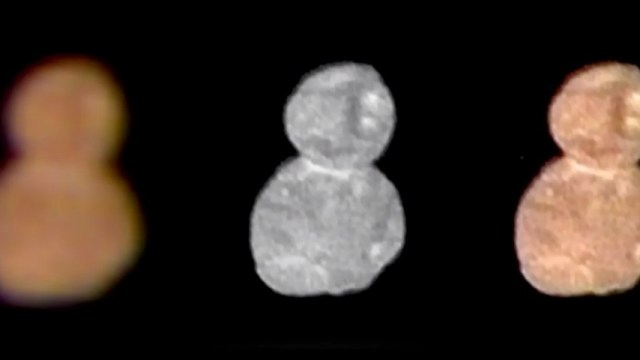The Galaxy That Challenged Dark Matter (And Failed)
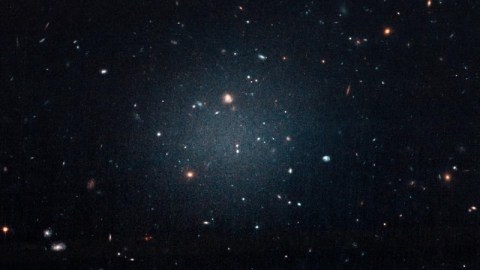
Dark matter is one of the most puzzling, unintuitive concepts in all of physics. But we still need it.
Our Universe isn’t like us. While we’re made of atoms, and other forms of normal matter, cosmic-scale observations indicate that the overwhelming majority of the Universe is dark. There’s dark energy, driving the expansion of the Universe, and dark matter, holding the massive clumps and clusters together. Every known galaxy contains about five times as much dark matter than normal matter, leading to the gravitational phenomena we observe.
But there are exceptions. Earlier this year, astronomers revealed one of the most puzzling galaxies ever found, NGC 1052-DF2. It’s diffuse, as large as the Milky Way, but with less than 1% of our stars. Early observations indicated that it was missing most — if not all — of its dark matter. But does this galaxy really present a challenge for dark matter, or is something more complex going on? As 2018 comes to a close, here’s what we’ve learned so far.
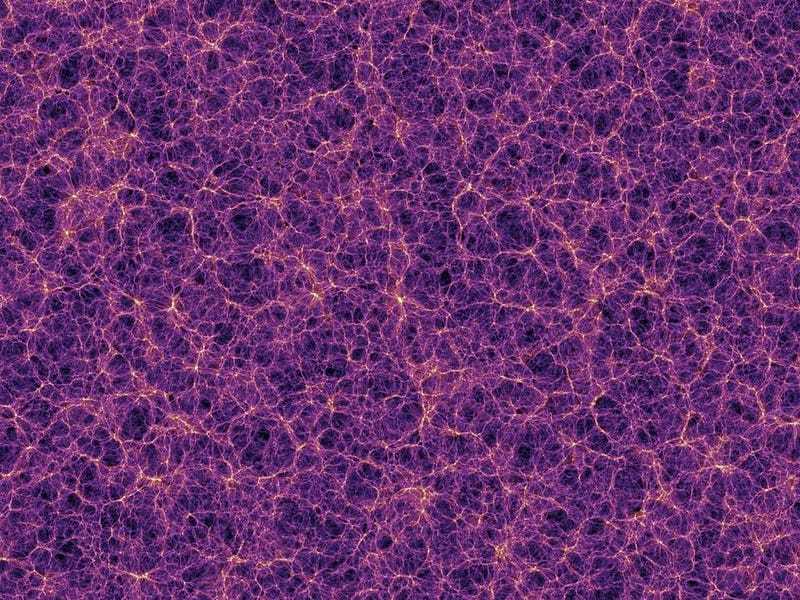
When the Universe as we know it first came into existence, it was hot, dense, expanding, almost perfectly uniform, and full of matter and radiation. As it expanded, it cooled, which takes energy out of the radiation. As matter came to dominate the Universe, gravitation began to draw additional mass into the overdense regions, leading to gas clumps, stars, star clusters, and eventually galaxies.
The Universe began to grow up in exactly this fashion: on the smallest scales first. In a Universe with the same average density everywhere, smaller distance scales means smaller masses. When you form new stars on small scales, the winds, radiation, and resulting supernovae can expel large amount of normal matter from inside. As a result, many of the small-scale galaxies we see today have varying ratios of dark matter to normal matter, rather than the standard 5-to-1.

But on larger scales, where galaxies grow to be comparable in size to the Milky Way, that 5-to-1 ratio is practically universal. Even the largest waves of star formation can’t expel significant amounts of matter from a galaxy. Only by moving rapidly through the rich environments of galaxy clusters can normal matter be pulled out of its home galaxy; galaxies found outside of clusters should be safe.
Which is why NGC 1052-DF2 came as such a surprise. Despite being the same physical size as the Milky Way, it doesn’t have any of the features we associate with our own galaxy. It’s not a spiral, it doesn’t have a disk, there’s no central bulge, and there are only about 0.5% as many stars as our own galaxy possesses. It’s also not an elliptical galaxy, so it isn’t just a different type from our own. But that’s nothing compared to the weirdness of what we found going on inside it.

In our own Milky Way, we have over 100 globular clusters spread in a halo-like shape throughout our galaxy. These objects are mostly clusters of hundreds of thousands to millions of stars, concentrated in a spherical region just a few dozen light years in radius. In most cases, they formed stars all at once many billions of years ago, and their stars move around inside much like you’d expect from the laws of gravity. And within our Milky Way, these globular clusters move around at hundreds of kilometers-per-second relative to one another, consistent with the Milky Way possessing a large, massive halo of dark matter.
In NGC 1052-DF2, however, the story was somewhat different. It has globular clusters like you’d expect. These globular clusters were a little larger than our own, but that’s not such a surprise. What was surprising, though, is that they all had roughly the same velocities as one another.
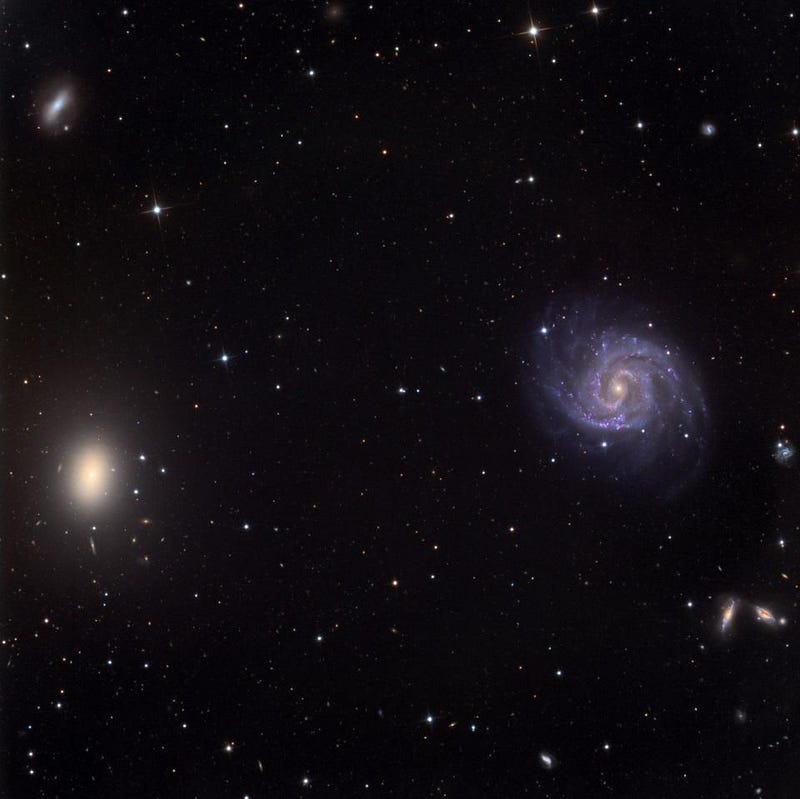
This observation seemed awfully fishy. In any galaxy, there should be a relationship between how quickly the internal objects move inside and the overall gravitational mass of what makes it up. This relationship manifests itself in many ways, depending on how you look at it. But maybe the simplest is to think about it in terms of energy: there’s a balance between potential and kinetic energies.
When you have a bunch of objects in a galaxy, all tugged on by the same overall mass, you expect to find some moving towards you and some moving away from you. You expect that the larger the overall mass, the bigger the differences in velocity between the ones moving towards you and away from you the fastest. Astronomers sometimes call this a velocity dispersion, representing the distribution of how quickly the different objects move relative to one another.

In the Milky Way, the velocity dispersion is large between globular clusters, with an overall range of around ±200–300 km/s, similar to the speed of the Sun around the galactic center. But in NGC 1052-DF2, the movements of the globular clusters were so small, it was as though there was very little mass at all, with practically no room for dark matter.
It’s possible that the measurements are in error, but that doesn’t appear to be the case. It’s also possible that there really is practically no dark matter inside these galaxies, but that’s a scenario that defies theoretical expectations. Before we claim either that “measurements are wrong” or “our theories are wrong,” it’s important to rule out the most likely culprit in these types of cases: that the measurements are right and the dark matter really is there.
If that were the case, we’d need to come up with an an independent method of trying to measure the dark matter.
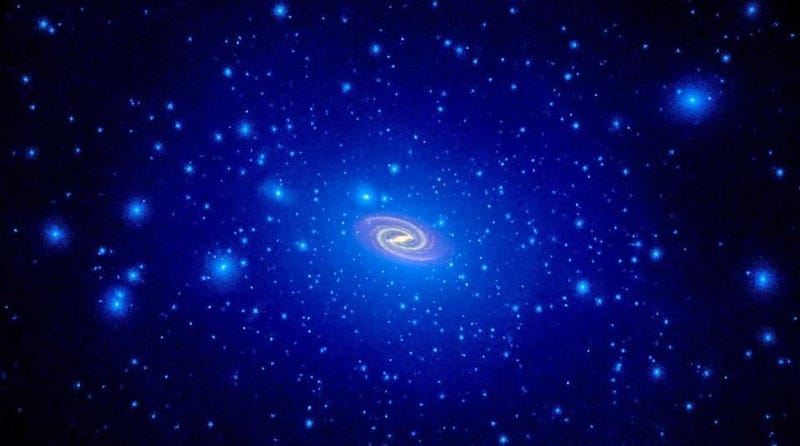
There’s an obvious way that the measurements could be right while the galaxy still contained dark matter: if the globular clusters we observed moving weren’t representative of how the matter in the galaxy actually moved. From deep within the Milky Way, we can observe globular clusters evenly distributed throughout it. But if we only found globular clusters located at the farthest point in their orbit from the center of NGC 1052-DF2, they would be biased towards artificially low velocity dispersions.
It’s unclear why this would be the case, but at a distance of 65 million light-years, NGC 1052-DF2 is at an awkward distance: right at the limit of where Hubble can resolve individual stars. Being an ultra-diffuse galaxy makes this measurement even more challenging, but by gathering many spectroscopic measurements across the galaxy and adding them all up together, you can measure the velocity dispersions of the actual stars inside the galaxy.

This is a more direct measurement of the galaxy’s mass than the globular cluster measurements. By measuring how all of the stars are moving inside, we can get a much better handle on how the stars inside are moving relative to the galaxy as a whole.
Instead of a few point measurements that we use to infer the interior mass, we have a large suite of more continuous data. While the globular clusters showed very little relative movement, indicating little mass and almost no dark matter, there was a big assumption that was made: that the measurements we made of a handful of globular clusters were representative of the motions of the stars inside.
And when scientists made these measurements, they found that the stars inside were moving relative to one another, after all.

These results are the first spectroscopic analyses of the stars inside this ultra-diffuse galaxy, but show that there is a velocity dispersion, after all. It’s only a few percent the velocity dispersion of the Milky Way, with speeds of ±16 km/s, but that’s normal for an ultra-diffuse galaxy. The updated mass estimates you can infer, based on the stars inside the galaxy instead of just a few globular clusters, indicate that there ought to be significant amounts of dark matter inside after all.
Even with a small velocity dispersion from the stars of just ±16 km/s, this is enough to throw the previous “no dark matter” results into doubt. In addition, the team that made these measurements also made two additional globular cluster measurements and improved the measurements of five others, which implied an internal velocity dispersion of ±10.5 km/s from those 12 clusters in total.
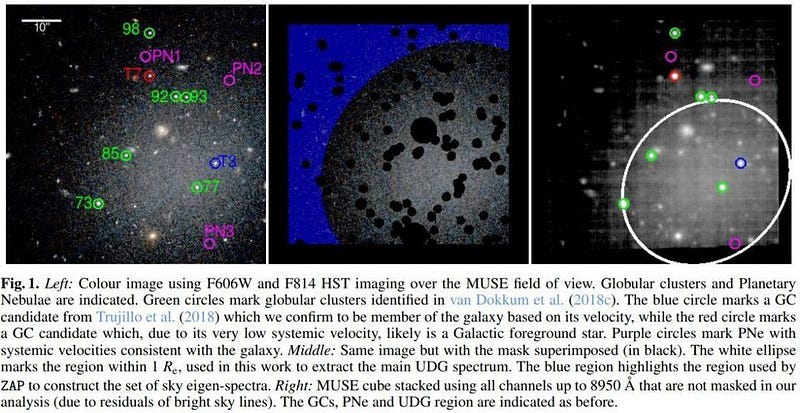
It’s fair to say that galaxies come in a great variety of shapes, sizes, densities and masses. Despite all that we know, there is so much we’re still learning as far as how they form, evolve, and grow up in the Universe. But whenever you have a surprising observation, the first thing you need to check is whether the conclusion it leads you to holds up when you make your observation using a different method.
These new observations don’t prove that dark matter exists, but they do remove a primary reason for doubting it. Instead of a single object that lacks a cosmic explanation, we now have an object that’s consistent with the observations of many similar objects in the same class. NGC 1052-DF2 is an interesting object that deserves further study, but it’s unlikely to have no dark matter at all. Although observations will always be our guide, this result highlights how important it is to independently verify your work before drawing grand, revolutionary conclusions.
Ethan Siegel is the author of Beyond the Galaxy and Treknology. You can pre-order his third book, currently in development: the Encyclopaedia Cosmologica.





